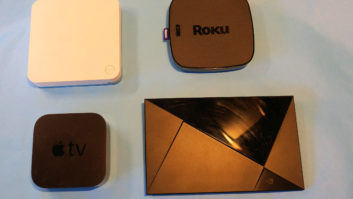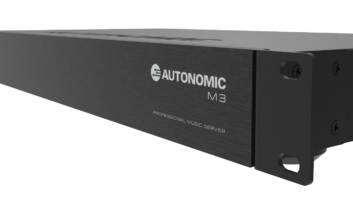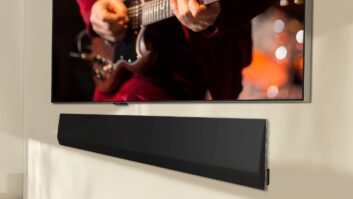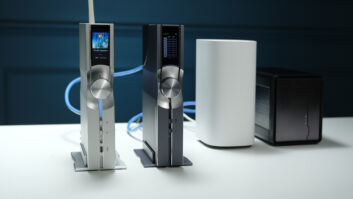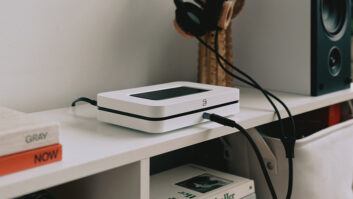As we enter the new year, it is inevitable that you’ll see a great deal of prognostication as to what the “hot trends, products, and services” for 2017 will be. At the top of many lists, along with UHD/4K displays, we’ll likely see a parallel increase in the availability of high resolution content.
Along with “standard 4K/UHD” an increase of high dynamic range (HDR) content in all distribution channels and media is expected. Along with that, a trend that has not gotten quite as much public attention, but which is certainly at the core of the incredible growth of OTT and “streaming services” is delivery of content by IP, rather than over-the-air, cable, or satellite. Yes, we know that broadband is the “pipe” that delivers these services, but the data within the pipe is IP. That, in turn, has created the need for devices that can receive the data, manage the content, and then decode it for output to displays and audio systems.
This is important not just for “cord cutters,” or people who previously paid for cable or satellite services but have dropped them, but also “cord nevers”–those who have never had any traditional video program connection, perhaps not even a TV antenna, but instead rely on the likes of Netflix, Hulu, Amazon, HBO GO, WatchESPN, and similar apps for content.

The new 4K-capable Chromecast Ultra (left) is only slightly thicker than the current model.
These two trends converge with the recent release of new products designed to accommodate IP delivery in general, and beyond that, 4K/UHD/HDR content. At the same time, Sling and PlayStation Vue, along with the recent introduction of DirecTV NOW, bring inclusive “streaming devices” to the fore as a means of entry for cord nevers, though none of the three multi-platform services deliver 4K content today. Between the two concepts, you have options for the high, middle, and lower end of the installation spectrum.
I’ve been called many things, but never a “cord cutter” and certainly not a “cord never,” even though I have a 4K smart TV, a TiVo Bolt and Roami, and a PlayStation. I use Roku devices throughout the home. Dedicated streamers are needed for access to “cable” without the need to pay for a set-top box in some rooms. That’s due to the Time Warner/Spectrum app, and those from other cable providers, such as the forthcoming Comcast/Xfinity “TV Partner” app.
Bottom line: streamers are a growing market that you need to know more about. Representative of the most recently introduced models, particularly with an eye toward full 4K and HDR, I compared two of the new Roku models, the new Chromecast Ultra, and the new Xiaomi Mi to see what they do and how they compare to older or existing models. (Disclaimer: The Roku products and the Chromecast Ultra discussed here were provided by their respective manufacturers.)
For the “cord nevers,” or for secondary rooms in large-scale installations, 4K is still not common, or even necessary. That’s where the new Roku Express is positioned, so I took it out for a test drive and compared it to a number of other Roku models around the house. The Express is the least expensive Roku to date, at a $29 retail price, bringing streaming to any TV with an HDMI input.
Considerably smaller than the Roku 1 and SE models it replaces, Roku Express is a basic, yet capable product. Thanks to an upgraded processor with twice the power of its predecessors, it loads key applications such as news apps, WatchESPN, Netflix, and Hulu in up to half the time of the older models. A few seconds might not seem important, but to those used to the instant channel change of internal ATSC tuners or cable and satellite set tops, they are important and the difference is noticeable.

Roku’s new Express models (center) are considerably smaller than the older Roku 1/SE (right), but are more powerful. The Streaming Stick (left) adds an RF remote and other features the others don’t have.
The Express’s wireless is 802.11 b/g/n, so the faster speed of “ac” isn’t available, but overall performance was acceptable. The remote and interface will be familiar to current Roku owners, and the unit may be powered by either the supplied 5VDC adapter or the USB port on most TVs. Beware, however, that some TVs also shut off power to the USB port when the set is off; in this case it is recommended that you use an external power adapter to avoid a boot up every time the display is turned on.
Its size is smaller, almost half that of previous models, leading some to think it may be mounted behind the TV. That would be a mistake, as the remote is IR only and must have line of sight to the device. A handy dual-sided, removable, adhesive strip is included with the product for mounting at the bottom of the set along the lines of a Wii Bar, but do keep this in mind when installing the Express models.
The new Roku Express is quite a feat of technology, but given another $20 I would recommend the second-generation Roku Streaming Stick, introduced earlier in 2016. Thanks to a quad-core processor, dual-band MIMO Wi-Fi, and a “point anywhere” RF remote, it can easily be hidden behind a set. Having used all three generations of the Streaming Stick, this $49 model fills all the requirements other than 4K, and I highly recommend it, even over the similarly sized Amazon Fire TV Stick, unless voice control from the remote is important to the installation.
That brings us to 4K, and that is where the real horse race starts. It is true that most 4K/UHD sets have extensive streaming app capability built in, but few, if any projectors do. Even with occasional service upgrades, a TV simply can’t offer or keep up with the growing number of streaming services. I’ve used the original Roku 4 for more than a year for just that reason, even though my UHD set has built-in apps.
There are now three 4K-capable Roku models: the Premiere at $79, the Premiere+ at $99, and the Ultra at $129. All 4K models offer 802.11 b/g/n/ ac with dual-band MIMO and a quad-core processor while the Premiere+ and Ultra include HDR-10 and the RF remote that is helpful when a Roku is inside cabinetry. The Ultra adds a host of other features such as a remote finder, an optical output, USB port, and voice search, via the remote. All new Roku models have voice search via the mobile app.
Having used the Roku 4 for a year, the proper comparison is to line it up against the new Roku Ultra. The video performance and load time are similar, but there are some physical differences. The new Ultra is 40 percent smaller than its predecessor. More importantly, the noisy and distracting fan in the Roku 4 has been eliminated in the Ultra (and the Premiere and Premiere+, too).
The continued availability of a “4K Showcase” as an aggregated compendium of both services that offer 4K content as well as individual movies and content that the user may access, along with Roku’s best-in-class interface, and the broadest and deepest selection of program channels, is what should put the Roku Ultra at the top of your recommendation list.
Unless, of course, not only 4K and HDR-10, but also Dolby Vision, are all required. That’s where the new Chromecast Ultra has a unique position in the market at $69. As was the case with the earlier Chromecast models, it is a slim, disc-shaped dongle designed to fit behind a display–there is even a magnet built into the case to secure it to the back of the set.
Also like its predecessors, which continue to be available at $35 for non- 4K video or audio-only streaming, there is no remote. Instead, you install the Google Home app on your iOS or Android device, connect it to Wi-Fi, and configure it. It may take some users a little instruction to stream content without the comfort factor of a remote, and there is not as great a range of apps, but when an Android phone is used, one may “cast any content to the screen just as the “mirroring” of an iOS device with an Apple TV does.
Here, however, is where the Chromecast Ultra earns its keep: it not only streams 4K content, but as of this writing (pre-CES) it is the only streaming product that accommodates Dolby Vision. With that likely to be of increasing importance this year, the feature is not to be ignored.

The Chromecast Ultra’s power supply is larger due to the addition of an RJ-45 connection. It must be used for 4K streaming.
Rounding at the comparison to the current models, the Ultra is slightly thicker, but not noticeably so. The most important physical/electrical change is that the included power adapter is hardwired to the “wall-wart” power supply. It’s also a bit larger than usual, as it not only adds an RJ45 port for wired ethernet connections, but also supplies slightly higher current.
That seems key, as you can plug a standard USB micro cable to the unit and then plug it directly into a TV or use any standard 5VDC adaptor sitting in the drawer. However, that is not recommended for optimal performance. Unless you use the supplied adapter, the viewer sees a message that “4K streaming is not available.” This may sound trivial, but it isn’t. If you use a Chromecast Ultra it is strongly suggested that you make sure that there is a power outlet within the length of the power cord as an extension is difficult.
Provided that the user is comfortable with the way a Chromecast is “driven,” you can’t beat the incredible Dolby Vision images. Oh, and at $69 it is $10 less than Roku’s least-expensive 4K model, and $30 less than the HDR-10 compatible Roku Premiere+.
One would think that the Chromecast Ultra would be the least expensive 4K streamer, but it isn’t. Also priced at $69 is the Mi Box from China-based Xiaomi. A large manufacturer of phones, headphones, Bluetooth speakers, power banks, and similar products, this is an interesting entry that differs from the Roku and Chromecast models.
Rather than use a proprietary interface, as Roku, Amazon Fire TV, and Apple TV do, or a phone/tablet-based interface as Chromecast does, it uses Android TV as its front end. Combined with a simple RF remote, it is easy to connect and set up, and the interface is easy to learn.

The Roku Ultra (center) is smaller than its predecessor, the Roku 4 (right). The Android TV-based Xiaomi Mi Box (left) is thinner and smaller still, but doesn’t have the program content of the Roku models.
Physically, it resembles the Roku models, though it is a bit more compact. There is no hardwired ethernet connection, but the remote includes voice search, something Roku offers only in its Ultra model or with its phone app. It also has HDR-10 for 4K and is unique in being the only product in the group with a 4K menu system. Performance is comparable to the others, but even with the Google Play Store onboard, the choice of available apps is less than the more established products.
With all of that, it is natural to ask which of the 4K streamers is best. In truth, the answer is job and client specific. For the widest range of “channels” and what I consider the easiest-to-use remote and onscreen interface, Roku takes the cake. Unless voice search and an optical output and other similar features are required, the Premiere+ is fine. For an extra $30, the Ultra covers all bases for expandability that might be needed.
If Dolby Vision is a hard requirement, the Chromecast Ultra is currently the only game in town. “Stream anything” mirroring from Android devices also makes it a logical choice from those in that ecosystem. With the Google Assistant in its new Pixel phones and the Google Home, you might find the Chromecast Ultra an increasingly attractive choice.
If price is critical, but HDR and a hard remote are important, one could do worse than the Xiaomi Mi Box. Once prospects get past the unusual and less-known branding and some of the quirks and limitations of the interface, it might just do the trick.
So, particularly for those with showrooms or display areas, it can’t hurt to buy one of each. For an investment of less than $300, you can be at the top of your game and let the client pick the interface, content selection, and quality that best suits them. After all, delivering results is what really matters, not the device, itself.
Michael Heiss is a CEDIA Fellow and contributing editor to Residential Systems in Sherman Oaks, CA.

